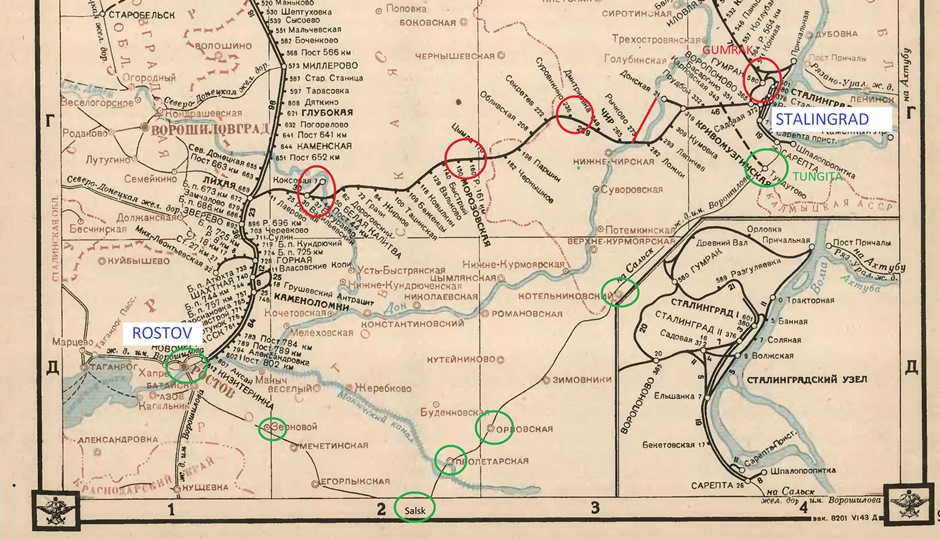
| Two railroads to Stalingrad to supply the German 6th Army and the Romanian 3rd, the 4th Panzer Army and the Romanian 4th Army |
|
Two main railroads were used to bring troops,
food, material and other supply to the fighting forces in and around
Stalingrad. The book Survivors of Stalingrad by Reinhold Busch has an eyewitness account of Joachim Feurich : Page 35-36
”On 23 October we finally arrived at our destination and de-trained
at Tchir on the Don. This is where the railway line to Stalingrad ended,
the final section having been destroyed at Tchir.” Then later on,
walking….”we set off. With a zest for action we reached Kalatch, got
into a waiting ammunition train – and headed for Stalingrad. Pioneers
had restored the railway line from here: it was single-track.
Then…”Towards evening we reached Gumrak, the last station
before Stalingrad: here the railway line ended“
Then the rail line traveled east another 130 miles or 210 km to the Chir River area. Because the Russians had completely destroyed the 2,500-foot or 762 meter long rail bridge over the Don during the fall, the rail head was located at the Tschir station about 16 km or 10 miles short of the Don. At this point all supplies were unloaded and transferred to trucks or horse drawn wagons. The supplies were then driven northeast about 38 km or 24 miles to a pontoon bridge over the Don and on to the village of Kalach. (red line on the map below) At the Kalach station, supplies were now loaded onto captured Russian trains running on a section of restored Russian Broad-Gauge track. These trains covered the last 64 km or 40 miles to the 6th Army in the Stalingrad area where they were unloaded. This entire transportation route was time consuming, inefficient and lacked sufficient carrying capacity. The
Southern railway :
The
Southern line crossed the Don at Rostov and came up from the south. This
rail line was used to supply the 4th Panzer Army and the Romanian 4th
Army South of Stalingrad.
The second rail route to
the area south of Stalingrad originated at the city of Rostov located at
the mouth of the Don River. This rail line then traveled south of the
Don via Kotelnikovo and then on to the front south of Stalingrad. This
line could handle some 4 to 5 pairs of trains per day and delivered
supplies directly to the 4th Panzer Army and the 4th Romanian Army."
Again a quote from an interesting newly
released book "The 64th Army at Stalingrad 1942-43" by Dann Falk
Page 157
Dann Falk "The 64th Army at Stalingrad 1942-43" Book available at Amazon.com Book Survivors of Stalingrad by Reinhold Busch Read more about the topic on : https://forum.axishistory.com/viewtopic.php?f=66&t=203286#p1832526 |
